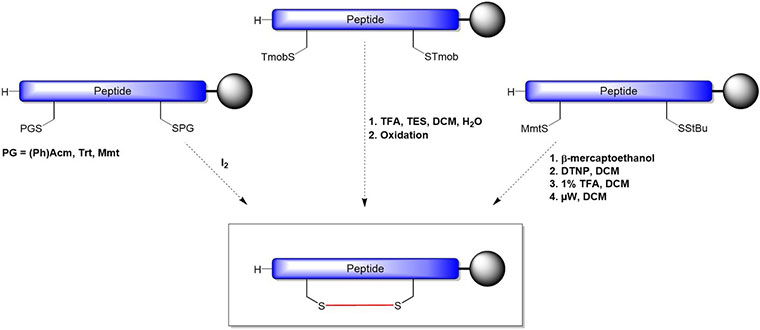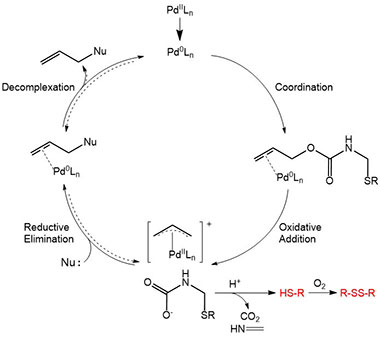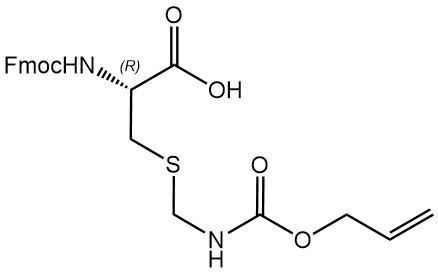The Allocam protecting group allows for selective deprotection and disulfide bond formation on-resin in one step.
The synthesis of disulfide-bridged peptides is a well-known challenge in peptide chemistry. When performed in solution, high dilutions have to be used in order to avoid intermolecular SS-bond formation. The on-resin formation of disulfide bonds has the advantage to favor intramolecular disulfide formation. Key on-resin methods include the treatment of peptides bearing (Ph)Acm-, Trt- or Mmt-protected cysteines with excess iodine, which may be problematic if electron-rich protecting groups are present (Postma and Albericio 2014,
Eur. J. Org. Chem.). Acidic cleavage of benzyl-type protecting groups such as Tmob, and subsequent oxidation of the resulting free thiols (e.g. using DMSO) also affords the corresponding disulfide bond. Another rather labor-intensive method for on-resin disulfide formation starts with the reductive cleavage of an StBu group, followed by oxidation with 2,2′-dithiobis(5-nitropyridine) (DTNP) to form RS–SNP. A single Mmt group is then cleaved under acidic conditions, and the resulting free thiol forms the desired SS-bond by microwave-assisted displacement of the SNP group (Galanis
et al. 2009, Pept. Sci.).

Key methods for on-resin disulfide bond formation.

The Allocam-protecting group, which is a variant of the Acm protecting group, allows for a palladium-mediated single-step approach using mild reaction conditions and readily available reagents. In a recently published synthesis of the C-carboxy analog of oxytocin (Kondasinghe
et al. 2017,
Org. Biomol. Chem.), complete conversion was achieved on Aminomethyl ChemMatrix® resin using 1.5 equivalents of Pd(OAc) 2 as catalyst, together with 3% NMM as well as 5% AcOH (v/v). No reduced peptide intermediates or S-allylated products were observed, and no residual palladium was detected in the final product. The reaction proceeds using the protected resin-bound peptide without loss of any acid-labile side chain protecting groups. By using Fmoc-L-Cys(Allocam)-OH, solution-phase manipulations of the peptide can be avoided, and the number of HPLC purification steps can be minimized.
Order our brand new booklet on Cyclic Peptides free of charge for more information on innovative Cysteine protecting groups and disulfide bond formation, or visit our Website to find more than 100 different Cysteine derivatives.
References:
- Direct palladium-mediated on-resin disulfide formation from Allocam protected peptides; T. D. Kondasinghe, H. Y. Saraha, S. B. Odeesho and J. L. Stockdill; Org Biomol Chem 2017; 15: 2914-2918. doi:10.1039/c7ob00536a
- Disulfide Formation Strategies in Peptide Synthesis; T. M. Postma and F. Albericio; European Journal of Organic Chemistry 2014; 2014: 3519-3530. doi:10.1002/ejoc.201402149
- Enhanced microwave-assisted method for on-bead disulfide bond formation: synthesis of alpha-conotoxin MII; A. S. Galanis, F. Albericio and M. Grotli; Peptide Science 2009; 92: 23-34. doi:10.1002/bip.21116
- Allylic protection of thiols and cysteine: I: The allyloxycarbonylaminomethyl group; A. Malanda Kimbonguila, A. Merzouk, F. Guibé and A. Loffet; Tetrahedron 1999; 55: 6931-6944. doi:10.1016/s0040-4020(99)00322-1
- Allylic protecting groups and their use in a complex environment part II: Allylic protecting groups and their removal through catalytic palladium π-allyl methodology; F. Guibé; Tetrahedron 1998; 54: 2967-3042. doi:10.1016/s0040-4020(97)10383-0
- Use of Alloc-amino acids in solid-phase peptide synthesis. Tandem deprotection-coupling reactions usingneutral conditions; N. Thieriet, J. Alsina, E. Giralt, F. Guibé and F. Albericio; Tetrahedron Letters 1997; 38: 7275-7278. doi:10.1016/s0040-4039(97)01690-0
- The allyloxycarbonylaminomethyl group: a new allytic protection for the thiol group of cysteine; A. M. Kimbonguila, A. Merzouk, F. Guibé and A. Loffet; Tetrahedron Letters 1994; 35: 9035-9038. doi:10.1016/0040-4039(94)88420-x
- S-2,4,6-trimethoxybenzyl (Tmob): a novel cysteine protecting group for the N.alpha.-(9-fluorenylmethoxycarbonyl) (Fmoc) strategy of peptide synthesis; M. C. Munson, C. Garcia-Echeverria, F. Albericio and G. Barany; The Journal of Organic Chemistry 1992; 57: 3013-3018. doi:10.1021/jo00037a013




 The Allocam-protecting group, which is a variant of the Acm protecting group, allows for a palladium-mediated single-step approach using mild reaction conditions and readily available reagents. In a recently published synthesis of the C-carboxy analog of oxytocin (Kondasinghe et al. 2017, Org. Biomol. Chem.), complete conversion was achieved on Aminomethyl ChemMatrix® resin using 1.5 equivalents of Pd(OAc) 2 as catalyst, together with 3% NMM as well as 5% AcOH (v/v). No reduced peptide intermediates or S-allylated products were observed, and no residual palladium was detected in the final product. The reaction proceeds using the protected resin-bound peptide without loss of any acid-labile side chain protecting groups. By using Fmoc-L-Cys(Allocam)-OH, solution-phase manipulations of the peptide can be avoided, and the number of HPLC purification steps can be minimized.
The Allocam-protecting group, which is a variant of the Acm protecting group, allows for a palladium-mediated single-step approach using mild reaction conditions and readily available reagents. In a recently published synthesis of the C-carboxy analog of oxytocin (Kondasinghe et al. 2017, Org. Biomol. Chem.), complete conversion was achieved on Aminomethyl ChemMatrix® resin using 1.5 equivalents of Pd(OAc) 2 as catalyst, together with 3% NMM as well as 5% AcOH (v/v). No reduced peptide intermediates or S-allylated products were observed, and no residual palladium was detected in the final product. The reaction proceeds using the protected resin-bound peptide without loss of any acid-labile side chain protecting groups. By using Fmoc-L-Cys(Allocam)-OH, solution-phase manipulations of the peptide can be avoided, and the number of HPLC purification steps can be minimized.